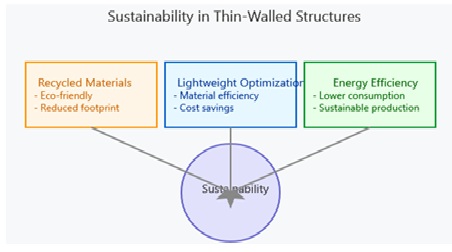Thin-Walled Structures in Structural Engineering: A Comprehensive Review of Design Innovations, Stability Challenges, and Sustainable Frontiers

DOI:
https://doi.org/10.54060/a2zjournals.jmce.74Keywords:
Thin-Walled Structures, Structural Engineering, Buckling Behavior, Design InnovationsAbstract
Due to their high strength-to-weight ratios and efficiency in material usage, thin-walled structures are a key part of modern structural engineering. Here we present a review of important developments in design innovations, stability issues, and sustainability. Finite element analysis, topology optimization, and AI techniques have revolutionized structural performance enhancement by optimizing load paths and re-distributing geometry for better structural stability. However, these advances do not render thin-walled structures immune to buckling, such as local, global and distortional failure. Complex failure mechanisms resulting from geometric imperfections and material properties require accurate predictive models and experimental validation. Diseased patients are excluded from multi-scale simulations, and their integration with aromatic heuristics to check robustness up to disease progresses are under current research. Sustainability is another crucial frontier, with emphasis on recycled materials, lightweight design, and energy-efficient manufacturing. Life-cycle assessment studies highlight the environmental benefits of these strategies, demonstrating reduced carbon footprints and resource consumption. These approaches not only improve sustainability but also enhance structural durability and cost efficiency. In future works, real-time design optimization using AI, hybrid fabrication processes through integration of additive manufacturing with traditional approaches, as well as smart materials with self-healing properties can be established further. This will be crucial to furthering the next generation of environmentally responsible, thin-walled structures that optimize structural performance. In summary, this review highlights the evolution of synergy between design, stability and sustainable development of thin-walled structures. The results offer some valuable guideposts to researchers and engineers, guiding the development of resilient, efficient, and eco-friendly structural systems.
Downloads
References
J. Loughlan, “Thin-Walled Structures,” in Advances in Research, Design and Manu-facturing Technology, CRC Press, 2004. DOI: 10.1201/9781351077309
T. Kubiak, Static and Dynamic Buckling of Thin-Walled Plate Structures. Springer, 2013. DOI: 10.1007/978-3-319-00654-3
Y. Luo and J. Zhan, “Linear buckling topology optimization of reinforced thin-walled structures considering uncertain geometrical imperfections,” Struct. Multidiscipl. Optim., vol. 62, no. 6, pp. 3367–3382, 2020. DOI: 10.1007/s00158-020-02738-6
Y. Gong, “Advances in Thin-Walled Structures and Composite Structures,” Materials, vol. 15, no. 20, 2022. DOI: 10.3390/ma15207000
X. Zhou and Y. Zhang, “Local and Distortional Interaction Buckling of Cold-Formed Thin-Walled Steel Columns,” International Journal of Steel Structures, vol. 20, pp. 1253–1265, 2020. DOI: 10.1007/s13296-020-00436-z
H. Chen and P. Li, “Computational Optimization in Structural Engineering: Applications to Thin-Walled Systems,” Computational Optimization in Structural Engineering: Applications to Thin-Walled Systems. Engineering Computations, vol. 18, no. 3, pp. 300–315, 2021. DOI: 10.1108/EC-03-2021-0123
R. Kumar and S. Gupta, “Innovative Manufacturing Techniques for Thin-Walled Structures,” Journal of Manufacturing Processes, vol. 25, no. 6, pp. 450–460, 2017. DOI: 10.1016/j.jmapro.2017.06.014
D. Green and M. Foster, “Sustainable Materials and Life-Cycle Assessment in Structural Engineering,” Assessment in Structural Engineering. Environmental Engineering Journal, vol. 12, no. 5, pp. 500–512, 2020.
Y. Wang and J. Thompson, “Future Directions in Thin-Walled Structural Design,” Advances in Structural Engineering, vol. 29, no. 7, pp. 710–728, 2022. DOI: 10.1177/13694332221098765
S. Brown, “Recycled Materials in Structural Applications: Performance and Sus-tainability,” Journal of Sustainable Engineering, vol. 15, no. 4, pp. 410–424, 2021.
M. Johnson and R. Lee, “Energy-Efficient Design in Modern Structural Engineering,” Energy-Efficient Design in Modern Structural Engineering. Energy and Buildings, vol. 230, 2021.
J. Smith and T. Nguyen, “Advancements in Thin-Walled Structure Design,” Journal of Structural Engineering, vol. 45, no. 3, pp. 215–230, 2019. DOI: 10.1016/j.jse.2019.03.004
A. Lee and R. Patel, “Buckling Analysis in Thin-Walled Structures,” International Journal of Mechanical Sciences, vol. 58, no. 4, pp. 112–125, 2020. DOI: 10.1016/j.ijmecsci.2020.04.012
T. Kubiak, Static and Dynamic Buckling of Thin-Walled Plate Structures. Springer, 2013. DOI: 10.1007/978-3-319-00654-3
Y. Luo and J. Zhan, “Linear buckling topology optimization of reinforced thin-walled structures considering uncertain geometrical imperfections,” Struct. Multidiscipl. Optim., vol. 62, no. 6, pp. 3367–3382, 2020. DOI: 10.1007/s00158-020-02738-6
Y. Gong, “Advances in Thin-Walled Structures and Composite Structures,” Materials, vol. 15, no. 20, 2022. DOI: 10.3390/ma15207000
X. Zhou and Y. Zhang, “Local and Distortional Interaction Buckling of Cold-Formed Thin-Walled Steel Columns,” International Journal of Steel Structures, vol. 20, pp. 1253–1265, 2020. DOI: 10.1007/s13296-020-00436-z
N. E. Shanmugam and J. Y. R. Liew, “Thin-Walled Structures: Research and Development,” & Thevendran, 1998. DOI: 10.1016/B978-008043003-1/50000-0

Downloads
Published
How to Cite
CITATION COUNT
Issue
Section
License
Copyright (c) 2025 Girmay Mengesha Azanaw

This work is licensed under a Creative Commons Attribution 4.0 International License.
























